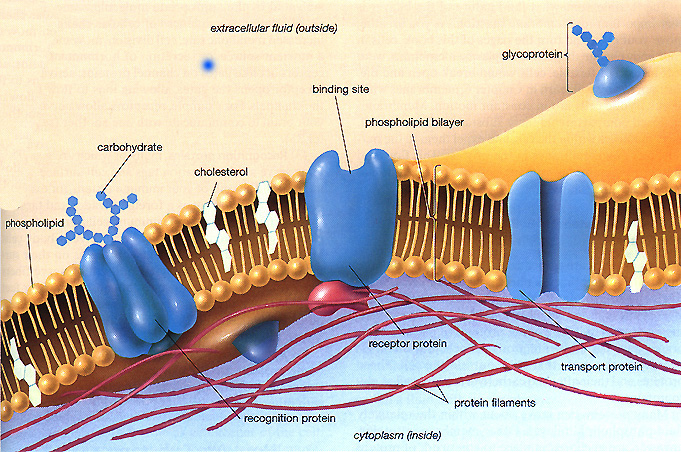The Fluid Mosaic Model
Biological Membranes are very small (7-10nm). At this size it is very hard to see the exact structure, even with an electron microscope. We therefore don’t know for sure exactly what’s going on, however, the Fluid Mosaic Model is generally accepted as describing how membranes are arranged.
The Fluid Mosaic Model states that membranes are composed of a Phospholipid Bilayer with various protein molecules floating around within it. The ‘Fluid’ part represents how some parts of the membrane can move around freely, if they are not attached to other parts of the cell. The ‘mosaic’ part illustrates the ‘patchwork’ of proteins that is found in the Phospholipid Bilayer.
Some proteins in the membrane are called ‘Intrinsic’. This means that they completely span the Bilayer. Others are called ‘Extrinsic’ - they are partly embedded in the Bilayer.

Membrane Components
Carbohydrate Polymers may attach to parts of the membrane, forming Glycolipids when attach to Phospholipid Molecules and Glycoproteins when they attach to proteins. Both Glycolipids and Glycoproteins can act as Cell Receptor Sites. Hormones may bind to them, as may drugs, to instigate a response within the cell. They may also be involved in Cell Signalling in the Immune System.
Some Intrinsic Proteins are Channel Proteins. These are Transport Proteins that allow the movement of molecules that are normally too large or too Hydrophilic to pass through the membrane by forming a tube-like structure that goes through the whole membrane.
Other Transport Proteins are Carrier Proteins. These use energy in the form of ATP to actively move substances across the membrane. For example, ions in the soil are actively transported in the root hair cells of plants.
Enzymes and Coenzymes may be attached to part of the membrane in order to carry out Metabolic Reactions. Mitochondria have infoldings of the membrane (called Cristae) containing Enzymes which are partly responsible for Aerobic Respiration.
The Steroid Molecule Cholesterol gives the Plasma Membrane in some Eukaryotic Cells stability by reducing the fluidity and making the Bilayer more complete.
Membranes and Heat
Increasing temperature increases molecular kinetic energy. This means that the Phospholipid Molecules in the Bilayer vibrate more and so are more unstable. This makes the membrane more ‘leaky’, as it will allow more molecules through that wouldn’t normally be able to. Once a certain temperature has been reached, the membrane breaks.
Some organisms however have adapted to live in environment with extreme temperatures, and so have membranes that are more resistant to heat. One way of increasing resistance to heat is by increasing the amount of Cholesterol in the membrane.